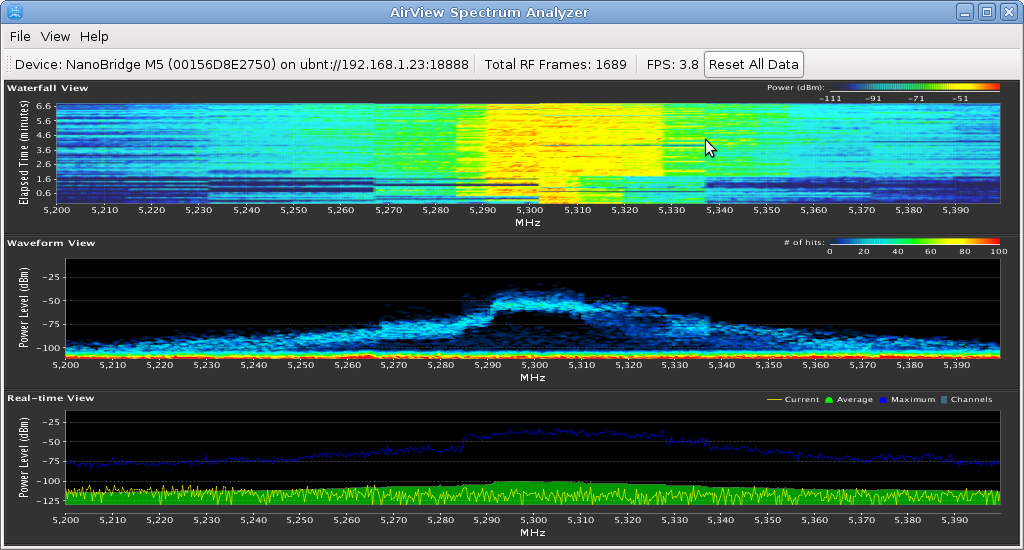- Contenu
- AirOS
AirOS¶
http://en.wikipedia.org/wiki/List_of_WLAN_channels
http://wireless.kernel.org/en/developers/Regulatory
http://wireless.kernel.org/en/developers/Regulatory/Database
Band [MHz] Max BW [MHz] Flags Max antenna gain [dBi] Max EIRP [dBm (mW)] 2402.000 - 2482.000 40.000 N/A 20.00 (100.00) => 80 MHz 5170.000 - 5250.000 40.000 N/A 20.00 (100.00) => 80 MHz 5250.000 - 5330.000 40.000 DFS N/A 20.00 (100.00) => 80 MHz 5490.000 - 5710.000 40.000 DFS N/A 27.00 (501.19) => 220 MHz (total 5 GHz 380 MHz, 5600-5650 = radar = 50 MHz)
http://www.ubnt.com/wiki/RF_Compliance
For example, if you select 5805 MHz (40 MHz channel) and Below, the radio will use (5775 to 5795 MHz) + (5795 to 5815 MHz),
but if you select 5805 MHz (40 MHz channel) and Above, the radio will use (5795 to 5815 MHz) + (5815 to 5835 MHz).
ath9k http://wenku.baidu.com/view/ac0523f57c1cfad6195fa7f4.html
Ubnt founder: http://www.forbes.com/forbes/2012/0116/entrepreneurs-robert-pera-computer-hardware-apple.html
Commandes utiles¶
gestion config via ssh: http://gregsowell.com/?p=3457
vi /tmp/system.cfg Once you have edited your config file, you must save it to flash: cfgmtd -f /tmp/system.cfg -w Once you have saved it you can reboot by issuing the “reboot” command or you can do a soft apply: /usr/etc/rc.d/rc.softrestart save
upgrade firmware via ssh: http://stfunoo.be/?p=1120
Statistiques¶
/usr/www/status.cgi /usr/www/sta.cgi root@LG7D92-204:/usr/www# grep cmd lib/settings.inc $cmd_cfgsave = "/sbin/cfgmtd -p /etc/ -w"; $cmd_cfgrestore = "/sbin/cfgmtd -p /etc/ -r -f " + $cfg_file; $cmd_cfgdef = "/sbin/cfgmtd -w -f " + $def_cfg_file; $cmd_reboot = "/sbin/reboot"; $cmd_ebtables = "/sbin/ebtables "; $cmd_iptables = "/sbin/iptables "; $cmd_regdomain = "regdomain "; $cmd_scanparser = "/bin/scanparser "; $cmd_brctl = "brctl "; $cmd_log = "/bin/cat /var/log/messages"; $cmd_webping = "/bin/webping"; $cmd_pppstats = "/bin/pppstats -a -r "; $cmd_wstalist = "/bin/wstalist"; $cmd_iwpriv = "/sbin/iwpriv"; $cmd_discover = "/usr/bin/discover"; $cmd_softrestart = "/usr/etc/rc.d/rc.softrestart "; XM.v5.5.4# wlanconfig ath0 list ADDR AID FREQ TxRATE RxRATE RSSI IDLE TXSEQ RXSEQ CAPS ACAPS ERP STATE 24:a4:3c:70:57:8b 1 5540 130M 130M 31 1 15 224 EPs 0 2a2b PS RSN RSN WME ATH VEN dc:9f:db:90:7f:c1 2 5540 130M 117M 41 12 13 192 EPs 0 2a2b PS RSN RSN WME ATH VEN XM.v5.5.4# mca-status deviceName=nsm5-louis-conte-230,deviceId=DC:9F:DB:90:80:7A,firmwareVersion=XM.ar7240.v5.5.4.16501.130308.1015,platform=NanoStation M5,deviceIp=172.20.31.230 apMac=DC:9F:DB:90:80:7A wlanOpmode=ap wlanConnections=2 wlanUptime=1977641 essid=TetaNeutralMones_230 freq=5540 signal=-61 noise=-88 ccq=991 uptime=1977641 loadavg=6 memTotal=29524 memFree=9032 memBuffers=2312 ackTimeout=33 distance=1350 lanIpAddress=0.0.0.0 wlanIpAddress=0.0.0.0 wlanTxRate=130.0 wlanRxRate=130.0 wlanTxLatency=1 wlanPolling=0 wlanPollingQuality=0 wlanPollingCapacity=0 lanRxBytes=3764340042 lanRxPackets=133042591 lanRxErrors=0 lanTxBytes=3721836526 lanTxPackets=98700656 lanTxErrors=0 lanPlugged=1 lanSpeed=100Mbps-Full wlanRxBytes=3895151823 wlanRxPackets=99541952 wlanRxErrors=0 wlanTxBytes=651529928 wlanTxPackets=137711468 wlanTxErrors=0 wlanRxErrNwid=13998 wlanRxErrCrypt=0 wlanRxErrFrag=0 wlanRxErrRetries=0 wlanRxErrBmiss=0 wlanRxErrOther=0 latitude=0.000000 longitude=0.000000 cfgCrc=945e619c ethtool eth0 wlanconfig ath0 list athtool athstats cat /proc/net/wireless cat /proc/net/dev
v5.3.5¶
http://wiki.ubnt.com/AirOS_5.3
Channel width 5/10/20/40
TX power min max dBm
Loco 4 23
NS 8 27
NB 4 23
Rocket -4 27
LocoM2 5/10/20/40 dBm 5-23
Comparaison¶
5.3.5 vs 5.5
Linux version 2.6.15-5.2 (buildd@builder) (gcc version 4.1.2) Mon Dec 19 20:46:46 EET 2011 (janvier 2006)
Linux version 2.6.32.54 (buildd@builder) (gcc version 4.1.2) Fri Apr 6 14:56:27 EEST 2012 (decembre 2009)
6842240 May 19 17:07 XM-v5.3.5.build11245.bin
6472831 May 19 17:07 XM-v5.5.build12536.bin
v5.5¶
http://www.ubnt.com/download#doc
http://www.ubnt.com/downloads/guides/airOS/airOS_UG_V55_3-20-12.pdf
Country Compliance Mode Frequency 4920 Mhz a 6100 MHz
Channel width 3/5/8/10/20/25/30/40
TX power min max dBm
Loco 4 23
NS -4 27
NB -8 23
Rocket -4 27
LocoM2 3/5/8/10/20/25/30/40 dBm 5-23 Freq 2312 a 2732 MHz (France 5/8/10/20/30/40 et 2412-2472)
IPv6 supported in command line ping6 fe80::xxx%br0 works
Tagger les 2 ports ethernet sur firmware 5.5:¶
NB:La NS doit déjà fonctionner sans VLAN en mode bridge.
Onglet Network:
- Configuration Mode: Advanced
- Ajouter le LAN0 avec VLANID 12
- Ajouter le LAN1 avec VLANID 12
- Supprimer LAN0
- Supprimer LAN1
- Ajouter LAN0.12
- Ajouter LAN1.12
Et appliquer la configuration.
Voila il reste plus qu'à configurer la machine/router pour utiliser ce vlan.
Exemple avec linux:
# ip link add link eth0 name eth0.12 type vlan id 12 # ip link set eth0.12 up # ping6 -c1 fe80::31%eth0.12 PING fe80::31%eth0.12(fe80::31) 56 data bytes 64 bytes from fe80::31: icmp_seq=1 ttl=64 time=23.5 ms --- fe80::31%eth0.12 ping statistics --- 1 packets transmitted, 1 received, 0% packet loss, time 0ms rtt min/avg/max/mdev = 23.519/23.519/23.519/0.000 ms
Forums¶
- http://community.ubnt.com/t5/airMAX-General-Discussion/Ubiquiti-products-700MHz-RF-leakage/m-p/797462#M40669
- Re: Ubiquiti products 700MHz RF leakage Ubiquiti devices operate within FCC limits. It's just the second harmonic from the CPU that could cause interference for Verzion equipment. Either firmware is FCC approved
- http://community.ubnt.com/t5/airMAX-General-Discussion/MU-MIMO/m-p/784294#M40495
To achieve MIMO from a conventional SISO system, several technologies have been proposed.
http://en.wikipedia.org/wiki/Beamforming
Beamforming alters the phase of each element in an antenna array to create spatial beam patterns through constructive and destructive interference.
http://en.wikipedia.org/wiki/Space%E2%80%93time_code
Space-time coding/processing performs antenna diversity with multiple antennas at either transmitter or receiver side or both sides, where every antenna element is separated from its nearest element by around 4 to 10 times the wavelength to keep the signal through each multi-path independent. The distance between two adjacent antenna elements is relying on the angular spread of the beam signal.
http://en.wikipedia.org/wiki/Multi-user_MIMO#Space-division_multiple_access_.28SDMA.29
SDMA is a common and typical multiple input multiple output scheme in cellular wireless systems. SDMA is often referred to as simply a MIMO system since the half port of a SDMA system also consists of multiple users. Although SDMA is indeed a MIMO technique, MIMO is not necessarily SDMA.
http://en.wikipedia.org/wiki/Spatial_multiplexing
Spatial multiplexing is performed by multiple antennas equipped at both a transmitter and a receiver front end.
http://en.wikipedia.org/wiki/Cooperative_wireless_communications
Cooperation are known as network MIMO systems, distributed MIMO systems or virtual antenna array systems. Mobile devices use the partnered mobile devices' antennas, antenna arrays, or antenna elements as virtual antennas."
proposed things despite "generalised" description in original company press-release: "MU-MIMO works by enabling simultaneous transmission to groups of clients, making better use of available WiFi network capacity and speeding up transmissions.
also wiki-suggested articles in reference - not bad(IMO):
http://dx.doi.org/10.1109/MSP.2007.904815
http://dx.doi.org/10.1109/JSAC.2013.130205
http://kth.diva-portal.org/smash/get/diva2:608533/FULLTEXT01
http://dx.doi.org/10.1109/TWC.2010.092810.091092
covering different aspects, but i found especially inreresting last two.
- http://community.ubnt.com/t5/airMAX-General-Discussion/NanoBeam-M5-19-why-is-NO-LONGER-gigabit/m-p/743292#M39584
Some initial units had a Gigabit port, but did not ship with Gigabit POE.
Gigabit LAN will be a feature for AC products and NBE-M5-400 and not NBE-M5-19 which will have 10/100Mbps ports. According to our research, there's no real need to include Gigabit port on NBE-M5-16/19 cause they're not for backhaul, in most cases will be used as CPE. In the other hand, NBE-M5-400 is being use as high distance CPE, but in most cases for PtP links.
ACK Hardware limits are:
40MHz - 15.2 miles (24.5 km)
30MHz - 32.5 miles (52.3km)
20MHz - 32.5 miles (52.3km)
10MHz - 65.2 miles (104.9 km)
8MHz - 65.2 miles (104.9 km)
5MHz - 130.9 miles (210.7 km)
References¶
References:- http://forum.ubnt.com/showthread.php?t=52560
- ETSI EN 301 893 v1.7.0 (2012-01)
- http://www.etsi.org/deliver/etsi_en/301800_301899/301893/01.07.00_40/en_301893v010700o.pdf
- See diagram page 17 of the ETSI PDF
- version plus recente http://www.etsi.org/deliver/etsi_en/301800_301899/301893/01.07.02_20/en_301893v010702a.pdf
- http://apps.fcc.gov/ecfs/document/view?id=7022123531
- Revision of Part 15 of the Commission’s Rules to Permit Unlicensed National Information Infrastructure (U-NII) Devices in the 5 GHz Band
- http://www.erodocdb.dk/Docs/doc98/official/pdf/ECCREP192.PDF
- The Current Status of DFS (Dynamic Frequency Selection) In the 5 GHz frequency range / Approved 6 February 2014 / Annex 2 amended 13 February 2015
AirView test¶
Lab on table same room compliance mode 5.5
- one NSM5 AP WDS
- one LocoM5 STA WDS 1 meter from the NSM5
- one NBM5 head (without dish) right in between Loco and NS running AirView
- associate NS and Loco with new frequency and width
- clear airview
- launch 300 second iperf client between netbook behind NSM5 to iperf server on locoM5
- after iperf is done save airview screenshot
- go back to step 1
First batch testing narrow channels 5240 with 5200-5300 airview:¶
- 3 MHz

- 5 MHz
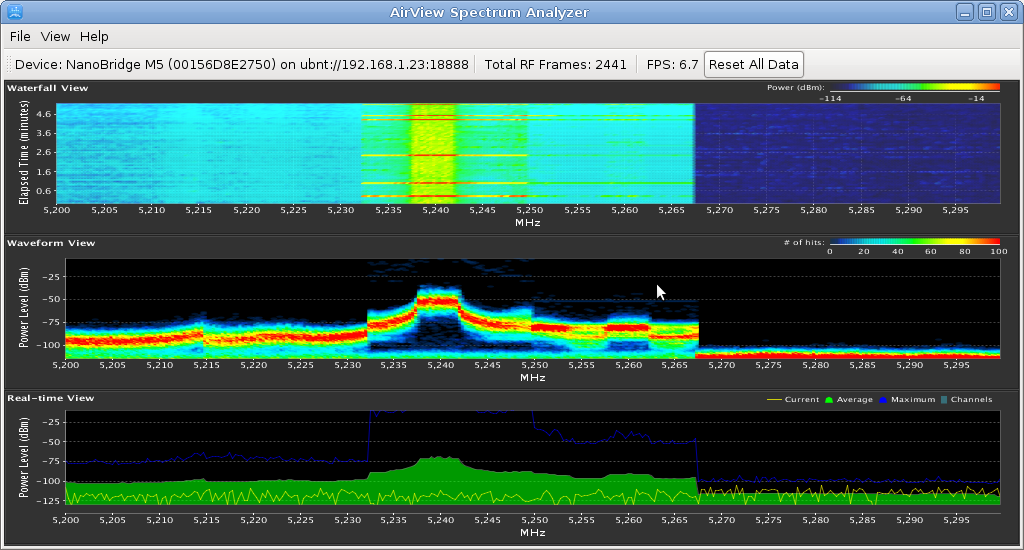
- 8 MHz
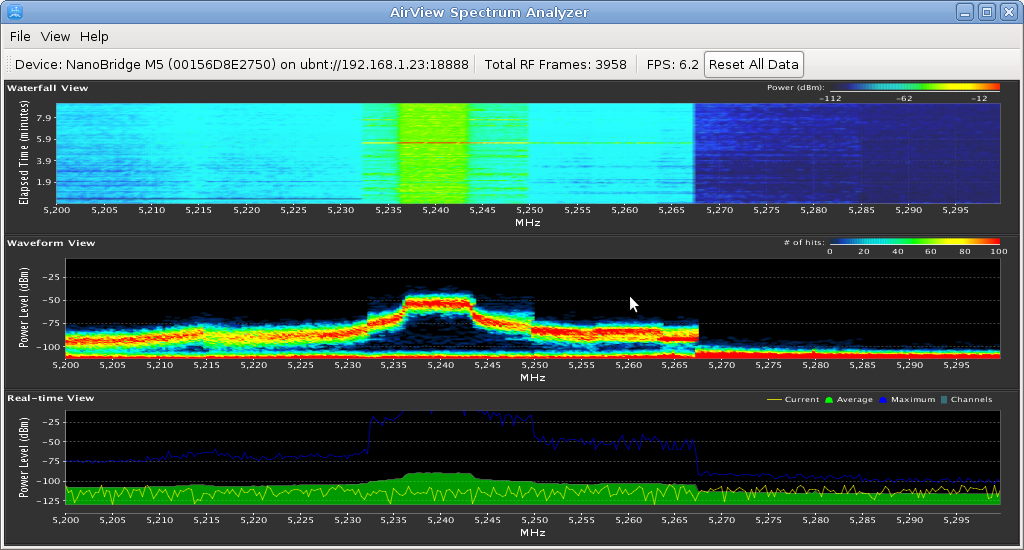
- 10 MHz
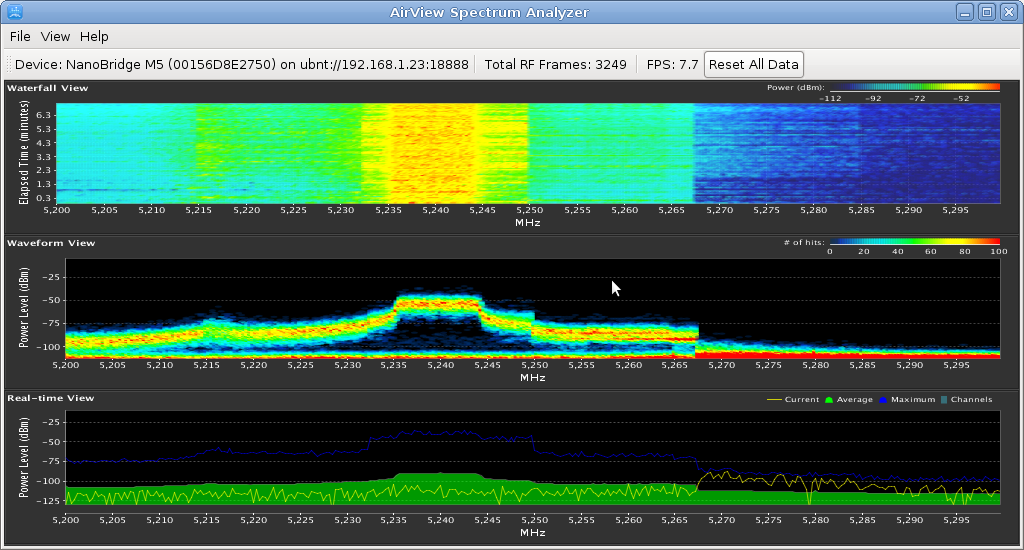
- 20 MHz
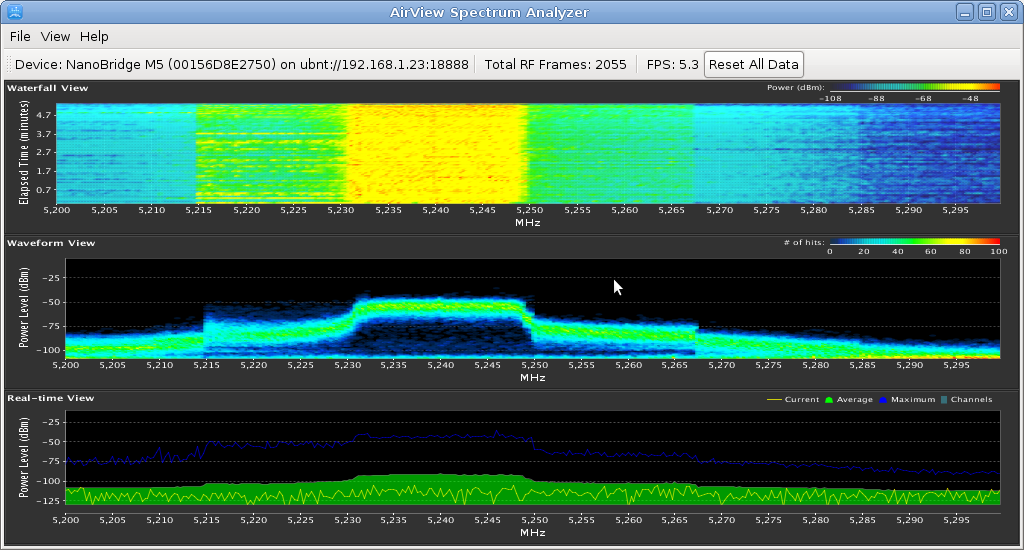
Second batch testing large channels 5300 with 5200-5400 airview:¶
- no emission to verify noise
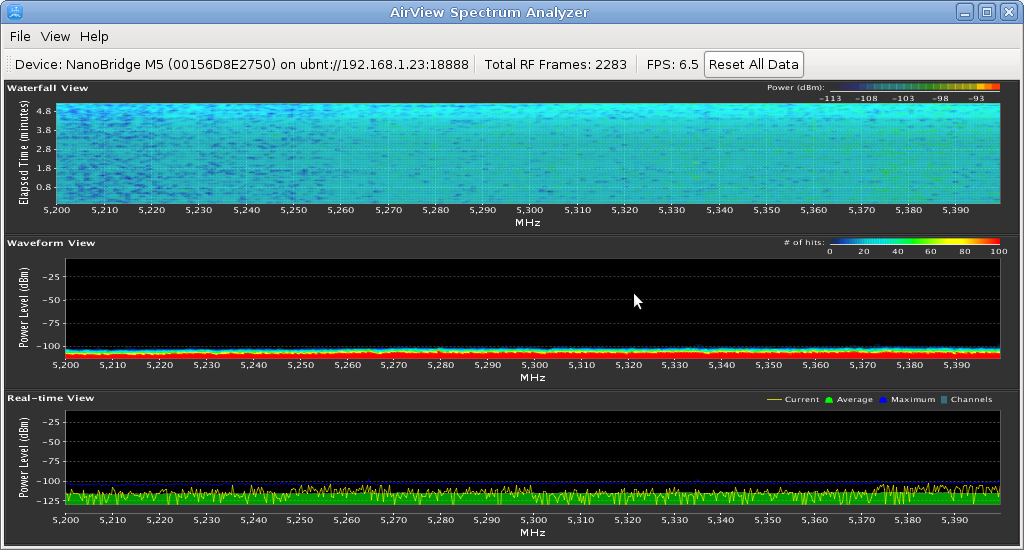
- 10 MHz
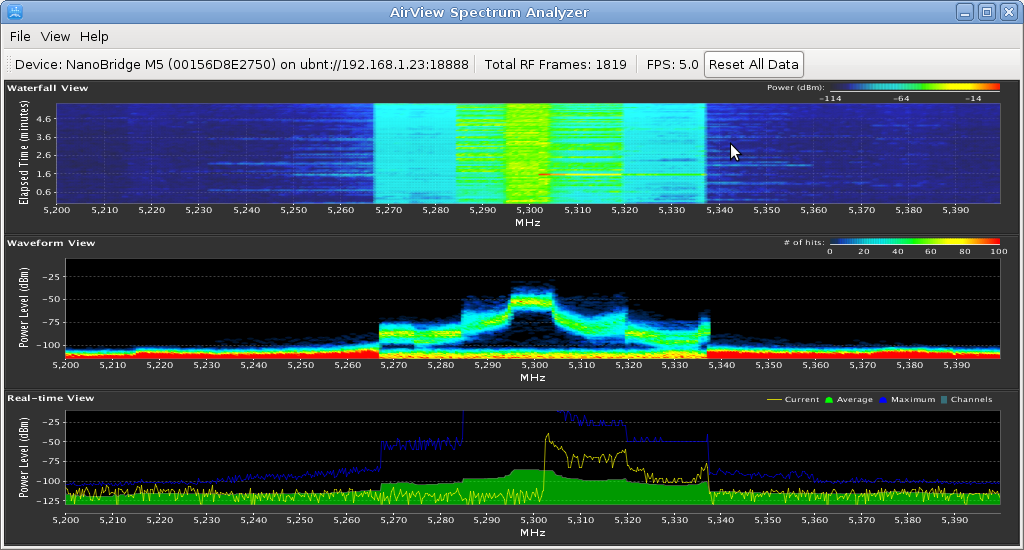
- 20 MHz
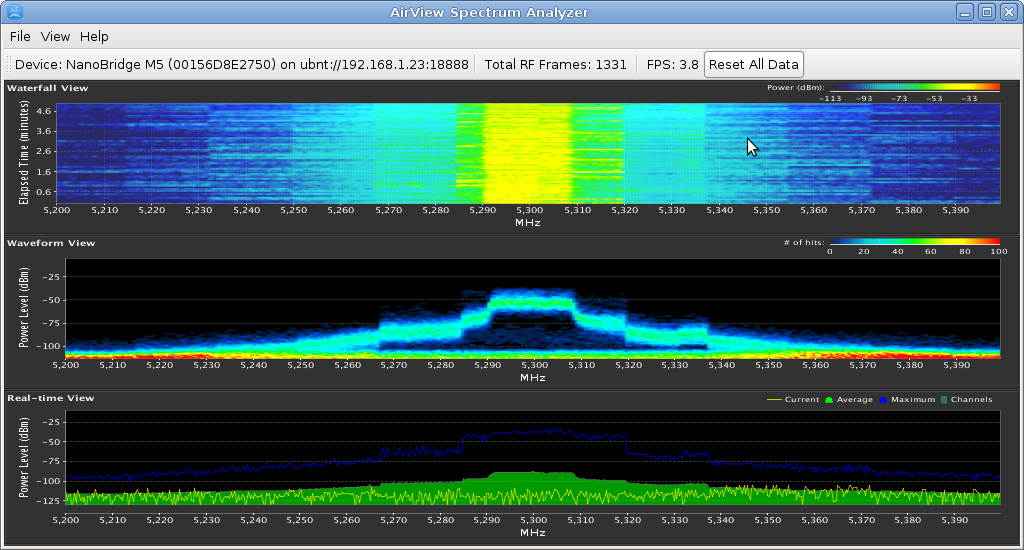
- 30 MHz
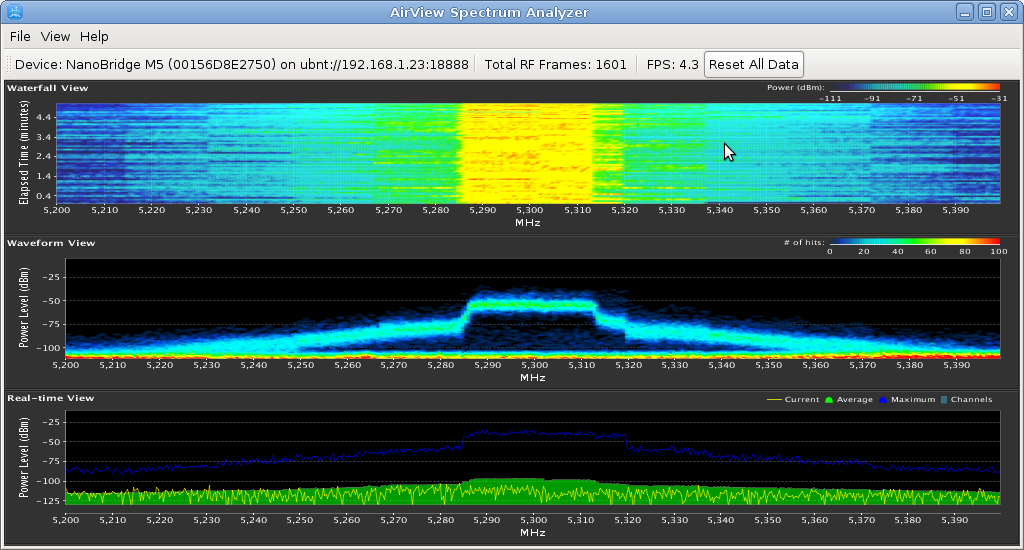
- 40 MHz
